Steph W. from SEOPressor


...help you check your website and tell you exactly how to rank higher?


75
score %
SEO Score

Found us from search engine?
We rank high, you can too.
SEOPressor helps you to optimize your on-page SEO for higher & improved search ranking.
By vivian on August 21, 2015
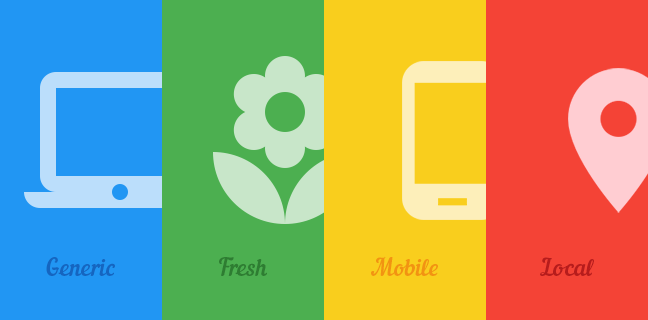
While I was digging around doing my Google patent research, I have this brief “eureka” moment – I realized that in achieving their goal to provide the best and most relevant search results, Google come up with a slew of algorithms to improve the quality of results returned. But Google also knows that high quality results alone is not enough.
What is considered “best” is highly dependent on the situation of the user when asking a query, for example, there is no point in returning Apple IPhone 6 when the user is hungry for some delicious fruit salad. Hence, Google not only strive to learn how to detect different query intent, but also employ different algorithms to address different situation once detected.
This is what I meant by the dimensions of a Google search result.
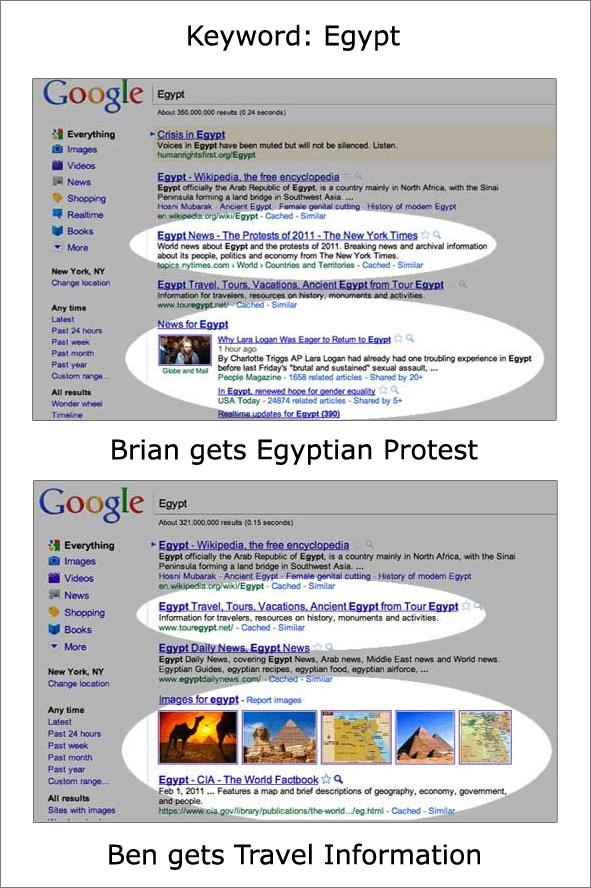
Same keyword can end up returning different results depending on the situation.
Essentially, Google asks why people are making the searches they do, and factors in details like the time the search was made, the platform the search was made on, and the location of the searcher.
Most people are still locked into the idea that Google has one universal set of results that exists across the board, and that’s not only wrong – but it’s also leading to companies that are ultimately trying to rank for everything, including dimensions that have little to do with their business.
Take for example the not-so-recent Mobilegeddon scare that got everyone into a frenzy trying to make their websites mobile-friendly. In my opinion, you know better than anyone whether mobile search is impactful for your business or the other way around. So depending on that, you might want to ignore the thing altogether.

From the word of God
Why? Because later on it was made clear that the mobile search dimension and the normal search are two separate realms. If your audience isn’t active on Googling on their smartphones or your contents are made out mostly of a lot of extensive academic papers nobody will read in tiny little screens, it might be ok for your website to be mobile-unfriendly. It won’t affect you that much (or maybe at all) as you are practically living in a different dimension.
With that in mind, hop into my interdimensional DeLorean as I guide you along the 4 dimensions that I have discovered so far and why you might want to move your entire business there. Buckle up, it’s going to be a bumpy ride.
[bof_display_offer id=7739]

This is the baseline for all search results – if nothing occurs to trigger a special result (one of the other three categories), then the search results will default to this catch-all category. This is the oldest dimension of all and the one we are accustomed to all this while when talking SEO.
Starting off with the famous PageRank algorithm, generic results now are fundamentally based on a large number of ranking factors such as:
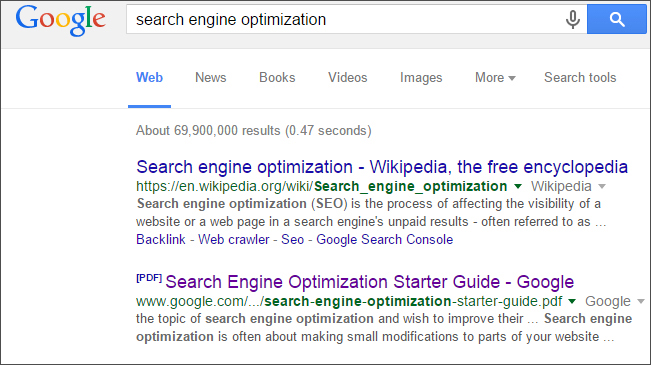
The majority of generic search is dominated by Wikipedia or sites that have high authority over the topic.
Normal Google search results also tend to be related to many types of queries – they typically function as repositories of facts and general information that is relevant all the time. Successful pages tend to be solid, capable of standing amidst a lot of competition, and have an evergreen/continuous nature to them. This includes things like general information or FAQs.
Generic search results shouldn’t be ignored just because they sound boring – they still are the largest portion of the search results. A single evergreen page may not bring in more than a few customers each month, but their very nature means that the long-term benefit to your business is phenomenal.
At the very least, most businesses will want to have a solid grounding in the generic search results, offering users some basic knowledge and information about the products and services being offered.
[TWEET “Google Generic result is a catch-all category to display the best results in general.”]

Also referred to as QDF or Query Deserves Freshness, fresh material is a completely different situation from generic pages when it comes to Google search results. This dimension of content revolves around frequently-updated subjects and news reports, such as:
Fresh content tends to have little or no long-term value, since the topic quickly grows stale and people will no longer be searching for it. This, of course, encourages many businesses to ignore it as a bad investment… but they’re missing out.
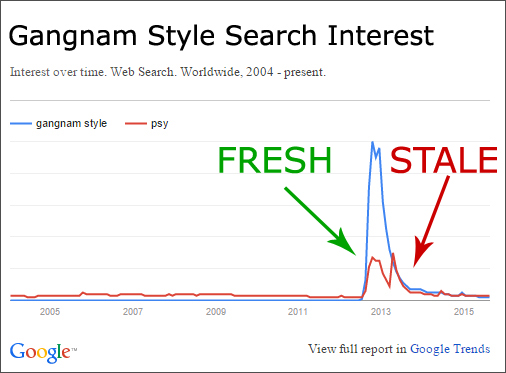
If you still write about Gangnam Style past 2013 you are definitely stale.
Let’s be honest here – outside of constant-update areas like sports and journalism, most businesses don’t need a lot of this kind of content, but there are still times when it can be extraordinarily valuable in the short term. Fresh content tends to have little competition, highly focused traffic,and a great deal of user interest – and that’s exactly what many companies are really looking to get.
Based on several Google Patents, here are some of the metrics Google use to label a content as Fresh:
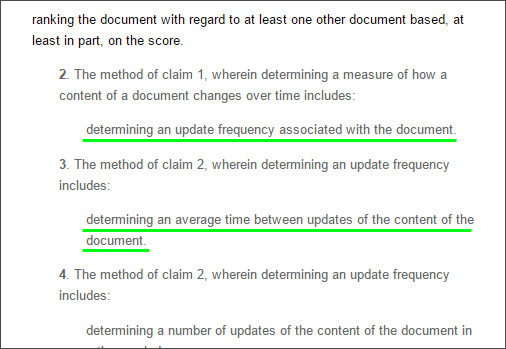
Google have several patents related to its Freshness Algorithm.
Some experts encourages you to continuously keep your old contents fresh by techniques such as repurposing and republishing old contents. But personally I believe rather than forcing a stale content to look fresh it’s better to instead be aware of trending topics and keep writing about hot new topics. When a topic starts to become stale just move over to the next best thing.
The best way for most companies to make use of fresh content is to focus on a kind of alert system – essentially, you’re letting your subscribers know when something happens that they should care about.
You can learn more about how your site’s Freshness Score is determined and ways of improving it – by visiting the Freshness section of our patent page. You can also learn more about how Google search results decide whether or not to apply this over a generic result by watching this old Moz’s video on the topic:
[TWEET “Google Fresh results applies a time-sensitive filter to prioritize only the most up-to-date results.”]

Mobile material is a relatively new category, but Google’s recent updates have turned it from a minor consideration into a major point of interest. There are a few key elements businesses needed to understand about this dimension of search results.
All search results here are specifically catered for mobile platform, and the Google search results algorithm prioritizes sites that are seen as mobile-friendly. Here, chances are your sites won’t be in the top ranking anymore if it’s not mobile-friendly even if they are featured as the first result in generic search.

Many SEO experts dubbed this change “Mobilegeddon” because of the impending doom faced by websites that aren’t mobile-friendly upon the day the update is unleashed.
The number-one factor in deciding whether or not to display this content is the platform the user is using – mobile results are intended to be displayed on mobile devices, and will rarely or never appear for users who are browsing from a desktop or laptop. In other words, you may need to focus on ranking in both generic and mobile search results if you want to have a good presence everywhere.
As things currently stand, mobile searches take up about 29% of all searches, and are a growing part of the market. They’ve actually surpassed many other types of searches, and in a very real sense, mobile is the future of searching for most people. It’s unlikely that desktop searches will entirely disappear – not as long as it’s still possible to do – but it’s no longer the main result in many areas.

Mobile users most of the time are already on the move and their search are related to what they are trying to accomplish that very moment.
On top of all this, mobile searchers tend to have a very different intent. Instead of a long, heavy read, they’re usually looking for quick information like:
Here’s the key point, though – you need to find out whether or not your users are accessing your site on mobile devices. The fact that many people are searching on mobile means effectively nothing if 95% of your traffic is still coming from desktop users.
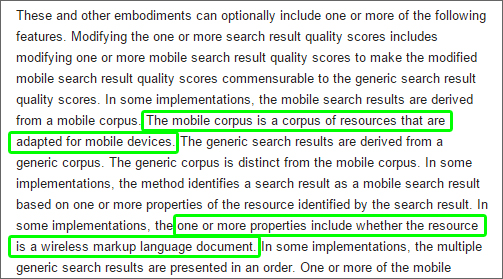
From “Blending mobile search results” patent.
Google detects mobile-friendly results from traits such as:
You can even use Google’s own tool to check if your website is mobile-friendly
You might need to focus almost entirely on mobile – or not at all, or anywhere in-between, depending on your target platform. This patent reveals that Google sometimes prioritizes “pure” results (purely desktop based for desktop search and vice-versa), so in some cases, trying to go for everything at once can actually hurt you if your business is focused in a specific platform.
Some additional information about mobile search can be found in our patent compilation page. You can also visit Google’s page on the subject when you’re done to help ensure that everything is in order.
[TWEET “Google Mobile results applies a platform-sensitive filter that prioritizes mobile-friendly results.”]

This is the last of the four major dimensions of Google search results that I have encountered for now, and it’s extraordinarily powerful for businesses that have physical locations. Essentially, Google takes your current location and applies it to the results of the search. If you search for “good restaurants”, for example, the results wouldn’t be very helpful if you got results for another continent… but they will be helpful if they’re all within 20-30 minutes of your current location.
There are two major ways of ranking in local search results:
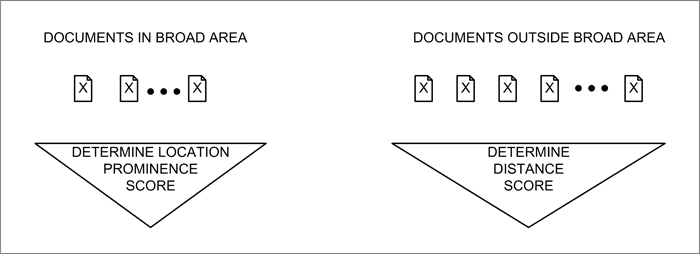
How Local Search Prominence is determined
Businesses can use many ways to get into local search results – they can join up on Google for Business, focus on getting reviews, ensure their location is known on Google Maps, be present in site listings and directories… basically, the idea is to be listed anywhere online that describes a physical region of the world.
Ranking prominently in local search results is excellent for obtaining local business and getting known throughout a given area. As noted here, the key factor in ranking well here is consistency – regular reviews (from trusted users, not fake accounts!), activity, and general value can ensure the optimum results when trying to show up locally.
The best part? Research shows that users are 50% more likely to make a visit after making a location-based query. This means that local searchers might very well be a serious buyer already in front of your doorstep!
[TWEET “Google Local results applies a location-based filter that prioritizes results nearest to the user.”]

Any 5th dimensional SEOs here to light the way?
Google is notoriously secretive when it comes to keeping most of its search algorithm hidden – and in fairness, they have solid reason to do so. By referring to Google patents, these are the four main dimensions that I’ve noticed, and while the reality is even more complicated than what’s been described here, these dimensions are the ones that I think most relevant for most businesses.
Surely in the future Google will expand the generic search into more specialized dimensions much like the existing ones. If you think there are other important dimensions I missed or which one Google might focus into next, feel free to drop a comment and let me know what you think!
Updated: 23 December 2025


Save thousands of dollars (it’s 100x cheaper)

Zero risk of Google penalty (it’s Google-approved)

Boost your rankings (proven by case studies)
Rank High With This Link Strategy
Precise, Simplified, Fast Internal Linking.
